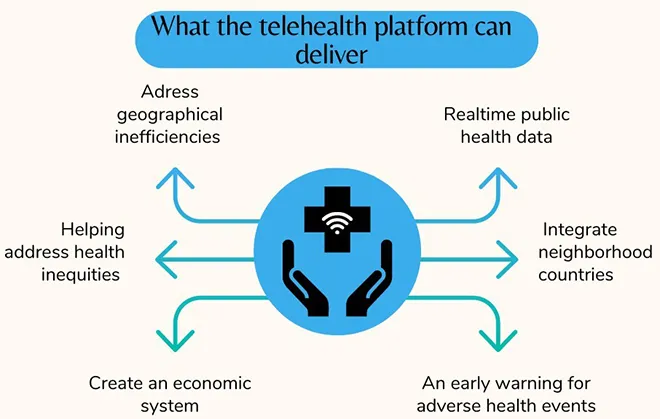
Telehealth has seen good traction in recent years, but much potential can be unlocked through platform-thinking, as it can help achieve better citizen health and faster responses to adverse health events like the pandemic. The Indian telehealth sector has private sector players like
Apollo Telehealth services and Practo Technologies, and public sector services like
eSanjeevani. Over the years, these services have expanded in scale and scope. eSanjeevani Health and Wellness Centre (HWC) is operational at around
80,000 HWCs and has registered more than
three crore teleconsultations by March 2022. It not only provides consultation services linking patients with doctors (eSanjeevani OPD), but also links doctors to other doctors (eSanjeevani Ayushman Bharat-Health and Wellness Centre). On the other hand, Practo Technologies has expanded to services like appointment booking and end-to-end surgeries, and have served around
17 crore patients in 2021.
Over the years, these services have expanded in scale and scope. eSanjeevani Health and Wellness Centre (HWC) is operational at around 80,000 HWCs and has registered more than three crore teleconsultations by March 2022.
While the telehealth market has expanded, it is quite segmented—private players mainly cater to the economically well-off, while eSanjeevani serves the poorer sections. This is true for doctors as well, with eSanjeevani having only government doctors and private sector players having private practitioners. Additionally, eSanjeevani has also imposed ‘state-boundaries’ on the digital platform, with residents of a state only being connected to government doctors of that state.
The Potential for an Open Digital Telehealth Initiative
There is potential for using platform thinking to establish a unified market for telehealth, that will vastly expand its scale and scope, and help build a valuable source of data for public health work. An Open Digital Telehealth Initiative (ODTI) links private and public healthcare institutions, doctors, and citizens in the country to enable connectivity, service delivery, and commerce within this ecosystem. It reimagines the scope of ‘
eSanjeevani’ and envisages a much larger canvas to play with, with a wider range of actors and services, using a mix of protocol and platforms.
Salient features of the proposed ODTI are:
- Connectivity across actors to break the segmented markets created by different platforms. All will be connected into a single market through use of standard protocols, that will then onboard both government and private sectors’ doctors and institutions, as well as patients across the economic spectrum.
- Enabling Service Delivery and e-commerce amongst all these actors. For this, it will need to integrate payment and aspects of video-audio communication within the platform.
- Mix of Platform and Standard Open Protocol: For wider market penetration, both an open protocol and platform will be useful. Private players can build their customised apps on top of the protocols, as done in Unified Payments Interface (UPI). Their marketing efforts will lead to higher patient penetration, and they can leverage the pan-India doctor network. Simultaneously, the protocols will ensure the standardisation of vital aspects like doctor onboarding, prescription formats, search-led discovery of doctors, and price comparison.
- Authentication of doctors and healthcare institutions can ensure that only state-registered doctors are onboarded by using a government approved closed registry.

Why does Open Digital Telehealth Initiative Matter?
Fig: Potential benefits of Open Digital Telehealth Initiative
Help address geographical inefficiencies: India has huge
regional disparities when it comes to number of doctors, whether it is the urban-rural differential or between states. For example,
Tamil Nadu has more
doctors per capita than the World Health Organization’s recommended norm. In fact, there were calls in the state
to limit the number of medical graduates. This scenario is alien to most other states.
A unified Indian telehealth market will enable a doctor to serve patients, regardless of their location and thereby, utilise the ‘excess doctors’ in one area to service patients in other geographies. This is also important for specialty practices, where patients often have to travel to bigger cities to avail these services. Similarly, enabling doctor-to-doctor consultations can help build a network of accessible expert advice, no matter the remoteness of the area. eSanjeevani currently enables doctor-to- doctor consultations for second opinions and group consultations, but only within government institutions. The Open Digital Telehealth Initiative can help expand this network to private institutions and doctors as well.
For private doctors and healthcare institutions, this will expand the market beyond their physical location and provide them access to patients across India.
Create a unified telehealth market: With this, the telehealth ecosystem will change to a unified pan-India one across patients, doctors, and institutions, and eliminate segmentations of state-boundaries or private and public. For private doctors and healthcare institutions, this will expand the market beyond their physical location and provide them access to patients across India. Simultaneously, the number of telemedicine providers on the platform will also expand. Patients will be able to compare prices across doctors, before selecting one that they are comfortable with. This will also pressurise the expensive doctors to offer better quality services or lower their fees.
Addressing other health inequities: This platform can help address inequities based on community and economic status. For example, tribal communities
susceptible to hypertension can be provided with targeted subsidies for cardiac care. This can be enabled through e-RUPI, which allows for initiative-specific spending. Similarly, migrants often
face difficulties in communication, thereby reducing their accessibility of the healthcare system. A language-based filter can allow them to select and consult doctors conversant in their own language.
An early warning system for adverse health events: The data amassed by the private telehealth companies is not easily accessible for public health work. This platform can help aggregate and build a source of near real-time public health data pan-India. Access to this data will enable the monitoring of symptoms and disease surveillance across national, state, and local scales. Breakthroughs can be created in syndromic surveillance, whether it is understanding the shifting patterns of diseases, or creating an early warning system for epidemics and adverse health events. The access to data will allow better epidemic and pandemic intelligence and help improve the prevention, control, and diagnosis of diseases. This data can also be used to create a health profile for all regions and thereby, formulate the right local health policies.
The digital repository of medical records will allow patients to share their medical documents and track whether proper guidelines for prescriptions and diagnosis are being followed by healthcare professionals.
Data for other public health goals: The standardised protocols of ODTI will help access a larger scope of data as well, such as medications being prescribed. An important indicator, changes in antibiotic prescriptions can be an early sign of antibiotic resistance. The digital repository of medical records will allow patients to share their medical documents and track whether proper guidelines for prescriptions and diagnosis are being followed by healthcare professionals.
The ODTI also has the potential to provide an overview of the health indicators which will facilitate the assessment of the healthcare system of the economy. The per capita numbers will provide an insight into the functioning and trends of health-related indicators in real-time and help understand the demand-supply ecosystem better.
Integrating neighbouring countries: Just like UPI, telehealth services can be expanded to other countries. India had close to seven lakh medical tourists in 2019, primarily from neighbouring countries. In 2019, Bangladesh alone accounted for
57.5 percent medical tourists in India. Thus, ODTI can potentially enable cross-border healthcare services to other countries. Along with boosting the economy, it will also help India become the
telehealth centre of the world.
Privacy and other concerns: As ODTI will capture sensitive personal information, strong measures to ensure privacy and data security are critical. In addition, minimising instances of
harassment and misconduct will need to be implemented to ensure a safe atmosphere for both patients and doctors. The
National Medical Commission’s drafted guidelines can be implemented robustly, by integrating it within the architecture and processes of the platform.
Conclusion
Creating and deploying ODTI will be a huge improvement in telehealth services and aid in achieving the National Digital Health Mission’s aim of providing accessible and affordable healthcare services for all. This will not only aid the pace of growth of healthcare services across the country but will also help deliver a wide set of public health goals.
The views expressed above belong to the author(s). ORF research and analyses now available on Telegram! Click here to access our curated content — blogs, longforms and interviews.



 Telehealth has seen good traction in recent years, but much potential can be unlocked through platform-thinking, as it can help achieve better citizen health and faster responses to adverse health events like the pandemic. The Indian telehealth sector has private sector players like
Telehealth has seen good traction in recent years, but much potential can be unlocked through platform-thinking, as it can help achieve better citizen health and faster responses to adverse health events like the pandemic. The Indian telehealth sector has private sector players like 

 PREV
PREV



